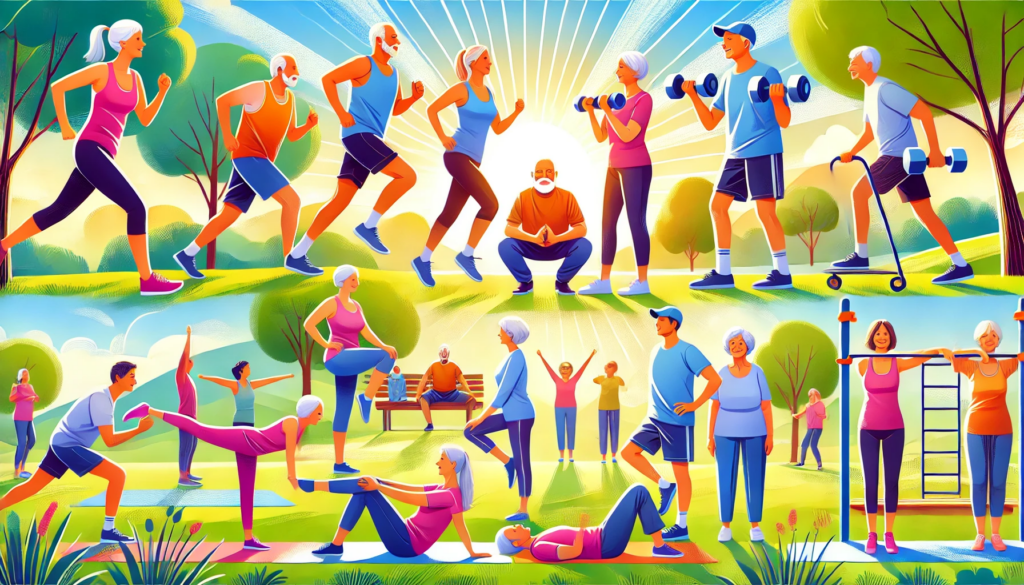
ChatGPT:
Four Types of Exercise to Improve Health and Physical Ability: A Comprehensive Guide
🏋️♂️ Introduction
Regular exercise is essential for physical health and well-being, especially as we age. While many people focus on a single type of activity, research reveals that incorporating a variety of exercises—endurance, strength, balance, and flexibility—yields the greatest benefits. This guide explores each type of exercise, its unique advantages, and practical strategies to integrate them into your routine.
🏃♀️ Endurance Exercises: Building Cardiovascular Health
Definition and Benefits:
Endurance exercises, often called aerobic activities, increase heart rate and breathing to improve cardiovascular, lung, and circulatory health. They help prevent conditions like diabetes, heart disease, and some cancers while boosting energy for everyday tasks.
Examples:
• Brisk walking or jogging
• Swimming and biking
• Yard work (mowing, raking)
• Dancing and climbing stairs
• Playing tennis or basketball
Weekly Goal:
Aim for at least 150 minutes of moderate aerobic activity weekly. Short bouts of 10–15 minutes throughout the day can add up to reach this target.
Safety Tips:
• Warm up with light activity and cool down afterward.
• Stay hydrated, dress for the weather, and use safety equipment.
• Pay attention to your body: stop if you experience pain, dizziness, or unusual discomfort.
🏋️♀️ Strength Training: Empowering Muscles
Definition and Benefits:
Strength exercises use resistance to build muscle power, which makes daily tasks like carrying groceries or climbing stairs easier. Strong muscles improve balance, reducing the risk of falls and injuries.
Examples:
• Weightlifting or using resistance bands
• Wall push-ups and arm curls
• Gripping a tennis ball
• Carrying groceries
Best Practices:
Exercise all major muscle groups at least twice a week but avoid training the same group two days in a row. Start with light weights or resistance bands and increase gradually as strength improves.
Safety Tips:
• Breathe regularly: exhale as you lift, and inhale as you relax.
• Consult your doctor if unsure about specific exercises.
⚖️ Balance Exercises: Preventing Falls
Definition and Benefits:
Balance exercises focus on stability and coordination, crucial for preventing falls. They are particularly beneficial for older adults and complement lower-body strength exercises.
Examples:
• Tai Chi, a gentle “moving meditation”
• Standing on one foot
• Heel-to-toe and balance walking
• Standing from a seated position
Safety Tips:
• Have a sturdy chair or person nearby for support.
• Practice regularly to build confidence and strength.
🤸♂️ Flexibility Exercises: Enhancing Range of Motion
Definition and Benefits:
Flexibility exercises improve the ease of movement, making activities like tying shoes or turning to look behind you simpler. They also help prevent stiffness and discomfort.
Examples:
• Back stretch and inner thigh stretch
• Ankle stretch and back-of-leg stretch
Best Practices:
Stretch after endurance or strength exercises when muscles are warm. Hold each stretch without bouncing and breathe normally throughout.
Safety Tips:
• Avoid overstretching to the point of pain.
• Consult a doctor for any concerns about specific stretches.
🎯 Staying Motivated to Exercise
Consistency is key to reaping the benefits of exercise. Below are strategies to maintain motivation:
💡 Make Exercise Fun
Engage in activities you enjoy, whether it’s dancing, swimming, or gardening. Incorporate variety to keep things interesting and prevent boredom.
⏳ Fit It Into Your Day
Combine exercise with daily tasks, like walking the dog or taking the stairs. Short sessions of 10 minutes can accumulate to meet fitness goals.
👥 Exercise with Others
An exercise buddy or group activity can boost commitment. Options include dance classes, lunchtime walks, or family sports outings.
📊 Track Progress
Monitor your workouts with an exercise plan. Set achievable goals and reward yourself for milestones, such as a movie or a massage.
🔄 Adapt to Life Changes
Adjust your routine to suit new circumstances, whether it’s a vacation, recovery from surgery, or moving to a new community.
🏆 Coping with Breaks in Routine
Life events can disrupt exercise habits, but staying flexible ensures a return to activity:
• On vacation, explore fitness centers or sightsee on foot.
• During illness, start slow and rebuild strength gradually.
• After relocation, explore local fitness facilities and classes.
🌟 Conclusion
Incorporating a mix of endurance, strength, balance, and flexibility exercises is vital for physical and mental well-being, especially in older adults. These exercises complement each other, supporting heart health, muscle strength, stability, and range of motion. By making exercise enjoyable, tracking progress, and adapting to changes, anyone can maintain an active and fulfilling lifestyle.

FAQs
1. Why is it important to include all four types of exercise in my routine?
Each type of exercise—endurance, strength, balance, and flexibility—offers unique benefits. Endurance improves cardiovascular health, strength builds muscles for daily tasks, balance prevents falls, and flexibility enhances range of motion. Together, they provide comprehensive physical and health benefits.
2. What are examples of endurance exercises for older adults?
Common endurance activities include brisk walking, jogging, swimming, biking, dancing, climbing stairs, and yard work like raking or mowing. These activities elevate heart rate and breathing, improving stamina and heart health.
3. How often should I do strength exercises?
Strength exercises should be done at least two days a week, targeting all major muscle groups. Avoid working the same muscle group two days in a row to allow for recovery.
4. What are good balance exercises for preventing falls?
Effective balance exercises include standing on one foot, heel-to-toe walking, the balance walk, and Tai Chi. These exercises enhance coordination and stability.
5. When should I do flexibility exercises?
Flexibility exercises are most effective when done after endurance or strength activities, as warm muscles stretch more easily. Stretching regularly helps maintain range of motion and prevent stiffness.
6. How can I stay motivated to exercise?
Make exercise enjoyable by choosing activities you like, combining it with daily tasks, and including variety. Exercising with friends or family and tracking your progress can also help maintain motivation.
7. What should I do if I take a break from exercising?
If life events disrupt your routine, start again gradually. For example, if recovering from illness, rebuild strength slowly. On vacation, look for fitness centers or explore on foot. Adjust your routine as needed to fit your circumstances.
8. Are there safety precautions I should follow during exercise?
Yes. Always warm up before exercising and cool down afterward. Stay hydrated, dress for the weather, and use proper safety equipment like helmets when biking. Listen to your body and stop if you feel pain, dizziness, or discomfort.
9. How can I tell if I’m exercising at the right intensity?
For moderate-intensity activities, you should be able to talk but not sing. For vigorous-intensity, you can only say a few words before needing to take a breath.
10. What should I do if I’m unsure about an exercise?
Consult your doctor or a fitness professional before starting a new exercise, especially if you have health concerns or are recovering from surgery or illness.
11. Can I combine types of exercise in one session?
Yes, many activities, like dancing or yoga, combine elements of endurance, balance, and flexibility. This can make exercise more efficient and enjoyable.
12. What are some quick ways to add physical activity to my day?
Incorporate exercise into daily routines, such as walking while on phone calls, taking the stairs instead of the elevator, or doing housework like vacuuming or gardening.
13. How can I reward myself for reaching fitness goals?
Treat yourself with non-food rewards, like a new book, a massage, or a special outing, to celebrate your progress and stay motivated.
14. What equipment do I need for strength training?
You can use free weights, resistance bands, or your body weight for strength exercises. Beginners can start with light weights or no equipment and increase resistance over time.
15. Can older adults safely start exercising?
Yes! Most older adults can benefit greatly from regular exercise. However, it’s important to start slowly, choose activities appropriate for your fitness level, and consult a doctor if needed.

